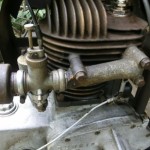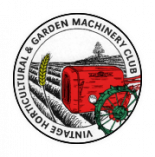Forum Replies Created
-
AuthorPosts
-
April 30, 2015 at 10:33 pm #12812
 wristpinParticipant
wristpinParticipantI’m no Howard expert but the clutch illustrated has the ball bearing thrust race to disengage it, so doesn’t that make it a 350? Didn’t all? the earlier 300 machines had the “fibre washer” thrust? Also, didn’t the Dowdswell 352 just have a simple fast and loose belt drive engagement/disengagement system – or was that the Dragon?
April 30, 2015 at 10:20 pm #12810 wristpinParticipant
wristpinParticipantThe free wheel units screw to a hub which is solid with the roller shaft. They can each spin freely in one direction only and should lock in the opposite direction ie with the engine off and the drive engaged you should be able to push the machine forward but not pull it back. If both rollers can be locked with the above test I would suggest that your problem is roller slip on the ground and not a mechanical issue.
From memory the free wheel units have a small arrow etched into them to denote the direction of drive. Again, from memory I think that it is possible to assemble the ratchet units to the shaft the wrong way round resulting in no drive being transmitted to that roller.
The attached scan shows the general layout.Attachments:
April 11, 2015 at 9:52 pm #12558 wristpinParticipant
wristpinParticipantSeem to remember that there’s a grub screw in the reverse side of the pulley hub – so no, it shouldn’t float!
April 11, 2015 at 9:49 pm #12557 wristpinParticipant
wristpinParticipantKeyed.
Timing, 1/8″ btdc.January 25, 2015 at 11:28 pm #11523 wristpinParticipant
wristpinParticipantHaving the right kit to re-face valves and re-cut seats “in house” is a great asset. My old Black and Decker must be 70 + years old but has repaid its £25 purchase price ,35 years ago, time and time again. It has the optional vernier valve stem grinder for valves adjusted in that way which is great for accurate setting. Fortunately having “been in the business” I have a set of Nu-way cutters for the seats.
I would advise a little caution in using one of your newly refaced valves to attempt to recover a bad seat – tends to make a mess of both. If you can’t beg or borrow a seat cutter at least use a dummy/scrap valve to dress the seat.January 15, 2015 at 6:26 pm #11451 wristpinParticipant
wristpinParticipantI’m guessing just ordinary mild but hopefully someone will know for sure.
December 24, 2014 at 8:14 pm #11211 wristpinParticipant
wristpinParticipantlower it you go to the bottom of the stroke where you then push the handle harder to overcome a strong spring to move the jacking pump into the lowering position.
Almost right, but its pull not push!
Was about to temporarily give up on it when I put my foot on the base, pulled the handle right it out and down it went under the action of the two retractor springs. Quite a stretch with no load to hold it in place.
Have subsequently found this website that is packed with information about just about every jack made but not, it appears, this one. I’ll keep you posted.December 22, 2014 at 3:38 pm #11151 wristpinParticipant
wristpinParticipantApologies for the orientation of the images, they were correct when they left me and in the pre-view! Something to do with the ipad, I guess!
No, have not tried a weight on it but will give it a go.
No sign of any manufacturer’s name on it but what paint remains is yellowy orange and at the back of my mind I have recollections of some other garage equipment in a similar colour, possibly one of those oil tanks and pumps in a cabinet that were usual of garage forecourts back in the fifties.
Those of us of a certain age will remember oil being served in glass bottles that were refilled from such a cabinet and brought out in a crate with a handle containing six or eight bottles.
Local garage sold both Castrol and Havoline and had a cabinet for each with a roller shutter that could be closed and locked after hours.December 11, 2014 at 6:22 pm #11041 wristpinParticipant
wristpinParticipantAs has been said the threads are most likely to be BSW or BSF but I recently worked on a JAP two-stroke that what at first sight appeared to be BSF were actually Cycle Thread. I was able to obtain a selection of cycle thread nuts from an Internet trader amusingly named Nooky’s Nuts!
November 30, 2014 at 2:44 pm #10859 wristpinParticipant
wristpinParticipantYes, two vee belts!
https://www.dropbox.com/s/55nx02tjfjonbbe/Webb%20AB1253%2C1255%2C1363%2C1473%2C14750001.pdf?dl=0Good luck with your search for handle grips, they used to snap like the proverbial carrots! When those machines were current we used to buy each of the grip sections five at a time!
November 29, 2014 at 11:16 pm #10856 wristpinParticipant
wristpinParticipantJust to make sure that we are talking about the same machine, the 1473 had one vee belt and one fine tooth flat belt + the very prone to breakage hard black plastic handle bar grips.
If this is the machine that you have I can post a parts list but not sure about an operator’s manual. As far as I know there was never a workshop manual.
As far as the Briggs engine goes there is plenty of information available. The official BS manual is the”Single Cylinder L Head” manual available in hard copy for around £20 and in various places on the net.
https://www.ppeten.com/forums/viewtopic.php?f=6&t=1014November 29, 2014 at 6:43 pm #10854 wristpinParticipant
wristpinParticipantQuite common on US made tillers and have also seen them fitted to snow blowers. Back in the 70s I worked on a Bolens rear engined rider with a vertical shaft Tecumseh that used the same system for reverse while the crank drove the machine forward through a 3-forward speed transmission.
In more recent times Ransomes have used both a Kubota and a Honda with cam drive to get the rpm low enough for their centrifugal clutch on the Mastiff. In that application the rotation of the engine is reversed so that the extended cam is running in same direction (counter clockwise) as a standard engine’s crank to avoid the need to re-engineer the transmission which remained essentially the same as when the Mastiff had first a JAP and then a Swiss made cast iron MAGNovember 16, 2014 at 11:18 pm #10729 wristpinParticipant
wristpinParticipantMany mower repairers will have a collection of coils with in built magnetron units taken from scrap machines. Around here you can pick one up for for a tenner or so. Problem solved without having to fiddle about un-soldering and re-soldering the early style clip on magnetrons.
Not a Stoic expert but I recollect that the push machines were either 3.5hp of 5hp – the fives being fairly obviously a bigger lump – and the power drive ones were 4hp.November 15, 2014 at 11:57 pm #10712 wristpinParticipant
wristpinParticipantWell done Hillsider, no its definitely not a lawn mower,so what’s it doing on the front of the OLC’s magazine.
Come again I’m old and rare, and I’m sure some would like me as a trophy as well!
You might as well stick a Traction engine picture on the front of The Garden Machinery magazine as some were Fowler ploughing engines.Calm down dear!
Think that if you re-read his post, Hillsider is actually defending the use of the pic on the front cover of Grassbox!
Live and let live, there’s enough strife in the world without squabbling over what is or isn’t a lawnmower!October 22, 2014 at 10:34 pm #10465 wristpinParticipant
wristpinParticipantI see where you are coming from re flushing out out the crap but I think that even Chinese copy engines are built to far higher standards than say original Villiers were. I have it on good authority that Loncin who produce quality Honda copies have, and may still do, build engines for Honda and also build engines for a certain German motorcycle manufacturer with a three letter name!
Also, something to bear in mind, is that the manufacturer’s initial oil fill may be a “running in oil” and if this is removed too soon and replaced with a top spec oil the bore may glaze and the rings may never bed in properly. The same goes for continuous light loading on a new engine.
As far as the oil spec goes, the manufacturer will have researched the requirement for an air cooled engine and made a recommendation based on their findings so stick to this recommendation both in viscosity and specification eg Sae 30, SF/SG.
Using fully synthetic in a horticultural engine may make you feel better but is reality is a total waste of money! -
AuthorPosts


